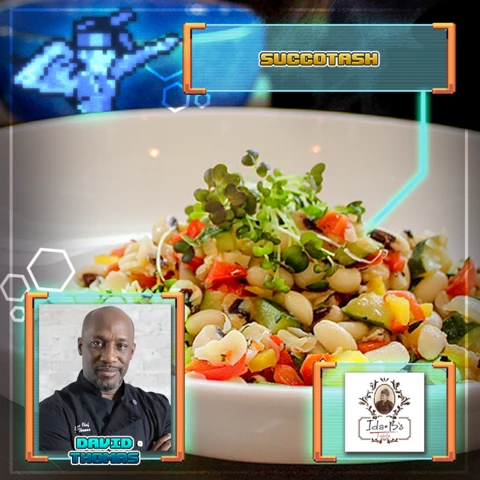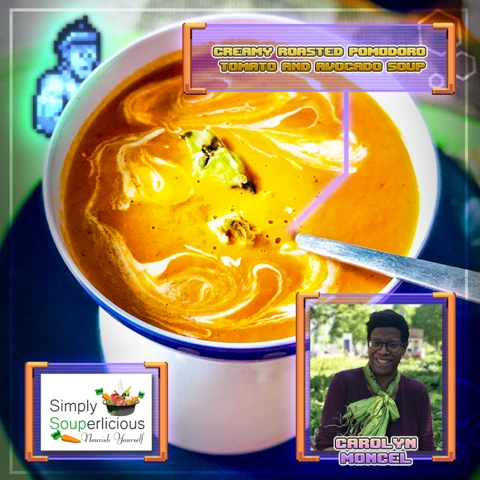Bullet Appétit - Volume Two
Food and Games. They go together like chicken and dumplings, coke and potato chips, Chewy and Chewella. It’s no surprise that the love for both runs universal. Even in video games, mixing strange digital herbs with other hard to find delicacies gained after fierce challenges are sometimes just the kind of thing you need when stepping up to take down a boss.

Everybody loves games, despite what your ex-girlfriend told you.

No Recipes
Marc Matsumoto is a private chef, culinary consultant, and TV host with a base of clients around the world that range from royalty to celebrities to restaurants. Born in Japan, and raised between the US and Australia, Marc developed an early love for travel and a broad palette of global flavors.
He spent 8 years as a marketing executive before launching a successful food blog with a large global audience. He believes that by making wholesome delicious food accessible to people of all backgrounds, the world becomes a better place. Marc’s goal is to use his unique positioning to teach basic cooking techniques and inspire people to follow their own culinary adventures.
Favorite Gaming Memory: "Geez, this is a tough one as I have so many, but here are two:
Getting a Japanese SuperFamicom in the US almost a full year before the SNES came out. Nintendo only produced 300k in the first run and they sold out almost instantly. My mom flew into Japan a few days after it's release and looked everywhere but couldn't find one. Somehow she convinced the manager of a shop to sell her a unit he was keeping to give his kids for Christmas. About 25 years later, my wife pulled off the same magic to get me a Switch at launch for my b-day *mind blown*”
Marc’s Bulalo

Marc Matsumoto: “Native to the Southern Luzon region of the Philippines, Bulalo is a light-colored soup that’s made rich by cooking beef shanks and beef marrow bones for hours, until much of the collagen and fat has melted into the clear broth. At its core, Bulalo a simple cattleman’s stew, best made in a large cauldron with whatever veggies are growing nearby.”

Cooking with Amy
Amy Sherman is a San Francisco based freelance writer and content developer who has written for food, travel, and lifestyle publications and clients including British Airways, Fodor’s, Food Network, Gastronomica, Via, and Westways. She also develops recipes for clients including USA Pears, Nasoya, and California Avocadoes. She is the author of A Microwave, A Mug, A Meal, wrote the new introduction to Jane Grigson's Vegetable Book, and the foreward to the reprint of Betty Crocker’s Good and Easy Cookbook.
Favorite Gaming Memory: “I had Blip, a game from TOMY in the late 1970s. It was clunky but I loved it!”
Amy’s Grilled Cheese, Pear and Turkey Sandwich

Amy Sherman: “One trick to getting this sandwich is right is to layer the ingredients just so. Start with a mustard slathered slice of bread and top it with cheese. The cheese and the mustard will kind of melt together. Put the smoked turkey in the middle and on the top put the pear. By grilling or toasting the sandwich on both sides in a pan you get a warmed through pear and gooey cheese that holds the turkey firmly in the middle.”

Culinary Hill
Born and raised in Wisconsin, Meggan Hill combines her Midwestern food memories with her culinary school education to create her own delicious take on modern family fare. There’s nothing she loves more than cooking for her family, cooking for friends, and cooking for every occasion! Food is love on Culinary Hill, and we definitely feel the same way.
Favorite Gaming Memory: “Favorite gaming memory: Playing Monkey Island with my older brother as a child - specifically the Insult Sword Fighting! Everybody should learn to cook because it’s an easy way to connect with other people. Plus we all need to eat - we need to keep up our strength so we can play more video games!”
Meggan’s Easy Goulash Recipe

Meggan Hill: “Sometimes, kitchen-sink dinners are the best kinds, thrown together purely out of hunger and what’s in the refrigerator. A long time ago, Easy Goulash probably started out as just that: something fast and filling that can feed a group—especially kids. That’s why it’s called Mom’s goulash, made by cooks all over the country.
In case you’re wondering, it’s definitely not a traditional Hungarian goulash, or even a German goulash. It’s more of an American goulash; a beef, mac and cheese concoction made in one single pot for easy clean-up.”

Chef David Thomas
The true embodiment of his catch-phrase “ Modern Soul”, Chef David Thomas has always had one foot in the kitchen. He was introduced to farm-to-table cooking by his grandmother, Anna Poole Thomas when he was a young boy. An African-American woman of Blackfoot Indian heritage, she fed her family almost exclusively with the things she raised on her 13-acre property. Drawing upon her teachings; his first restaurant Herb & Soul had built such a demand and following in six months, that they transformed the tiny carry-out into Herb & Soul: Gastro Cafe & Lounge, which went on to become a 4.5-star restaurant. His success continued when he opened Ida B’s Table in partnership with The Real News Network, a place where the truth is honored and ideas are exchanged. Chef Thomas has made it the restaurant’s mission to bring light to the history of Soul Food, and illuminate its future. On top of that, he has taken home the champion title TWICE on Food Network’s Chopped and again on Bite Club! He is currently working on a dinner series, more recipes, and a book that tells the story of Soul Food through food.
Favorite Gaming Memory: “ As a kid growing up, I was on a bowling team with my brother. We would get to practice early and stay after practice to play Galaga at the arcade. The best memory?My brother and I would play Call Of Duty. I am very much a history/war buff and experiencing the historical settings of COD really did it for me”
Chef David’s Succotash

Chef David Thomas: “ People should learn to cook because it is self sustaining. One must learn to feed oneself in order to survive. At some point you may even find that cooking starts to become a means of creativity and self expression.”

Paulie’s Kitchen
Paul Handley is the mind behind Paulie’s Kitchen. The social media account is the home of home-cooked recipes made easy and wrapped in fun. Paul is an avid gamer and a member of a small online Halo community called UK Elite.
Favorite Gaming Memory: “I remember falling in absolute love with Tekken 2. I used to practice on ultra-hard against the computer and got to the point where I couldn’t find anyone that could beat me! I practiced with all of the characters to learn all of their chain combos and special moves to know what was coming!”
Paulie’s Steak Quesadillas

Paul Handley: “A really simple but amazing recipe would be some quesadillas. This Mexican street food is delicious finger food which is ideal with some sour cream and some Guacamole. They are perfect for a bite in between breaks on long gaming sessions!”


































